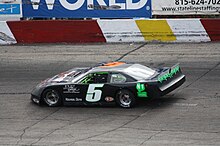In sports car racing, production-derived versions of sports cars, also known as grand tourers (GTs), and purpose-built sports prototype cars compete within their respective classes on closed circuits. The premier championship series of sports car racing is the FIA World Endurance Championship. The main series for GT car racing is the FIA GT1 World Championship. There is also the FIA GT3 European Championship as well as the less powerful GT4 European Cup. Previously, an intermediate FIA GT2 European Championship existed, but the FIA dropped it to cut costs. Other major GT championships include the Japanese Super GT championship and the International GT Open for GT2 and GT3 cars. There are also national GT championships using mainly GT3 and GT4 cars featuring professional and amateur drivers alike.
Sports prototypes, unlike GT cars, do not rely on road-legal cars as a base. They are closed-wheel and often closed-cockpit purpose-built race cars intended mainly for endurance racing. They have much lower weight and more down force compared to GT cars, making them much faster. They are raced in the 24 hours of Le Mans (held annually since 1923) and in the (European) Le Mans series, Asian Le Mans Series and the WeatherTech SportsCar Championship. These cars are referred to as LMP (Le Mans prototype) cars with LMP1 being run mainly by manufacturers and the slightly less powerful LMP2 cars run by privateer teams. All three Le Mans Series run GT cars in addition to Le Mans Prototypes; these cars have different restrictions than the FIA GT cars.
Another prototype and GT racing championship exists in the United States; the Grand-Am, which began in 2000, sanctions its own endurance series, the Rolex Sports Car Series, which consists of slower and lower-cost race cars compared to LMP and FIA GT cars. The Rolex Sports Car Series and American Le Mans Series announced a merger between the two series forming the WeatherTech SportsCar Championship starting in 2014.
These races are often conducted over long distances, at least 1,000 km (621 mi), and cars are driven by teams of two or more drivers, switching every few hours. Due to the performance difference between production-based sports cars and purpose-built sports prototypes, one race usually involves several racing classes, each fighting for their own championship.
Famous sports car races include the 24 Hours of Le Mans, the Rolex 24 at Daytona, 24 Hours of Spa-Franchorchamps, the 12 Hours of Sebring, the 6 Hours of Watkins Glen, and the 1,000-mile (1,600 km) Petit Le Mans at Road Atlanta. There is also the 24 Hours of the Nürburgring on the infamous Nordschleife track and the Dubai 24 Hour, which is aimed at GT3 and below cars with a mixture of professional and pro-am drivers.In North America, stock car racing is the most popular form of auto racing.[10] Primarily raced on oval tracks, stock cars vaguely resemble production cars, but are in fact purpose-built racing machines that are built to tight specifications and also called Silhouette racing cars.
Stock car racing
The largest stock car racing governing body is NASCAR (National Association for Stock Car Auto Racing). NASCAR's premier series is the Sprint Cup Series, its most famous races being the Daytona 500, the Southern 500, the Coca-Cola 600, and the Brickyard 400. NASCAR also runs several feeder series, including the Xfinity Series and Camping World Truck Series (a pickup truck racing series). The series conduct races across the entire continental United States. The NASCAR Pinty's Series conducts races across Canada and the NASCAR Toyota Series conducts races across Mexico.
NASCAR also governs several smaller regional series, such as the Whelen Modified Tour. Modified cars are best described as open-wheel cars. Modified cars have no parts related to the stock vehicle for which they are named after. A number of modified cars display a "manufacturer's" logo and "vehicle name", yet use components produced by another automobile manufacturer.
There are also other stock car governing bodies, most notably the Automobile Racing Club of America (ARCA).
In the UK, British Stock car racing is also referred to as "Short Circuit Racing". This takes place on shale or tarmac tracks – usually around 1/4 mile long. The governing bodies for the sport are the Oval Racing Council (ORC) and BriSCA. Both bodies are made up of individual stadium promoters. There are around 35 tracks in the UK and upwards of 7000 active drivers. The sport is split into three basic divisions – distinguished by the rules regarding car contact during racing. The most famous championship is the BriSCA F1 Stock Cars. Full-contact formulas include Bangers, Bombers and Rookie Bangers – and racing features Demolitions Derbies, Figure of Eight racing and Oval Racing.
Semi Contact Formulas include BriSCA F1, F2 and Superstox – where bumpers are used tactically.
Non-contact formulas include National Hot Rods, Stock Rods and Lightning Rods.
UK Stock car racing started in the 1950s and grew rapidly through the 1960s and 1970s.



No comments:
Post a Comment